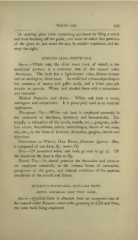Page 537 - My FlipBook
P. 537
WHITE OAK. 535
In opening glass tubes containing pyrozone by filing a notch
and then breaking off the point, care must be taken that particles
of the glass do not enter the eye, by sudden explosion, and de-
stroy the sight.
QUERCUS ALBA—WHITE OAK.
Source.—White oak, the dried inner bark of which is the
medicinal portion, is a common tree of the natural order
Amentacece. The bark has a light-brown color, fibrous texture
and an astringent, bitter taste. Its medicinal virtues depend upon
the presence of tannic and gallic acids, and a bitter principle
known as quercin. Water and alcohol form with it decoctions
and tinctures.
Medical Properties and Action. — White oak bark is tonic,
astringent and antiperiodic. It is principally used as an external
application.
Therapeutic Uses.—White oak bark is employed internally in
the treatment of diarrhoea, dysentery and hemorrhoids. Ex-
ternally in relaxation of the uvula, tonsils, etc.; gangrene, indo-
lent ulcers, leucorrhoea, atonic menorrhagia, fissure of the anus,
etc., etc., in the form of tincture, decoction, gargles, lotions and
injections.
Decoction of White Oak Bark, Decoctum ^ercus Alba.,
is composed of oak bark, ; water, Oj.
.5J
Of
Dose.—Of powdered white oak bark, gr. xxx to gr. xl.
the decoction the dose is f.^ss to f§j.
Dental Uses.—In dental practice the decoction and tincture
are employed externally in the various forms of stomatitis,
sponginess of the gums, and relaxed condition of the mutous
membrane of the mouth and fauces.
QUILLAYA SAPONARIA—QUILLAIA BARK.
SOUTH AMERICAN SOAP TREE BARK.
Source.—Quillaia Bark is obtained from an evergreen tree of
the natural order Rosacece—rose order, growing in Chili and Peru,
the inner bark being employed.


